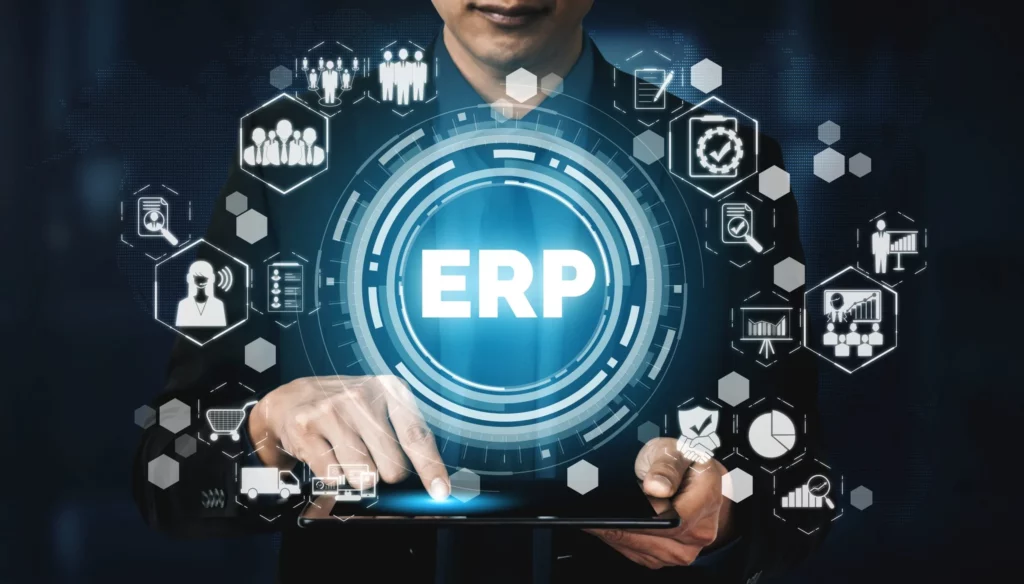Home Why is it important to consider the implementation of an ERP system in the business environment?
An ERP (Enterprise Resource Planning) is a comprehensive software designed to manage all operational and production aspects of a company. From human resource management, through financial management and inventory control, to production planning and customer relationship management (CRM), an ERP integrates all these functions into a single cohesive system. Its relevance in the modern business world is indisputable, as it offers a 360-degree view of the business, facilitating informed decision making and improving operational efficiency.
An ERP is essential for today’s businesses as it integrates all key operations into a single system, improving decision making and efficiency.

Today’s companies face complex challenges: from efficient resource management to process optimization and the need for agile, informed decision making. These challenges can hinder growth and competitiveness in an increasingly saturated market. This is where an ERP becomes a strategic partner, offering:
Implementing an ERP solves management, efficiency and decision making problems, allowing companies to be more competitive and agile.
An ERP (Enterprise Resource Planning) system is specialized software designed to manage a company’s main business operations in an integrated manner. This type of system facilitates the flow of information across all business departments, from finance and human resources to production and sales, enabling more efficient, data-driven decision making. ERP plays a fundamental role in improving operational efficiency, optimizing processes, and providing a unified view of business performance.
ERP integrates and manages all business operations, significantly improving efficiency and decision making.
ERP systems have evolved from simple resource planning systems in the 1960s and 1970s, initially focused on inventory management and production planning, to comprehensive solutions that encompass almost every aspect of business management. This evolution has been driven by technological advances, the need for real-time data integration, and the demand for complete business visibility. Digital transformation has played a key role in the development of modern ERPs, which now offer advanced capabilities such as data analytics, artificial intelligence, and cloud computing.
ERPs have evolved from basic planning systems to comprehensive solutions that support the digital transformation of companies.
ERP systems consist of various modules that focus on specific areas of business management. The main components include:
Each of these components works in an integrated manner to provide cohesive and efficient business management. The flexibility and scalability of ERP systems allow companies to customize and expand their solutions according to their specific needs.
ERP integrates key modules such as finance, human resources, manufacturing, and supply chain for efficient and unified business management.
The implementation of an ERP significantly improves operational efficiency in companies through:
Implementing an ERP optimizes operational efficiency by integrating and automating processes and reducing errors.
An ERP facilitates data-driven decision making by means of:
The data centralization and analysis tools offered by an ERP significantly improve decision making and planning.
ERP systems stand out for their scalability and flexibility, which makes them ideal for:
An ERP is adaptable and scalable, able to adjust and support the growth and diversification of any company.
ERP implementation also leads to improved customer satisfaction through:
An ERP improves the customer experience by optimizing inventory management, customer service and responsiveness.
Before implementing an ERP, it is crucial to conduct a detailed assessment of business needs and objectives. This includes:
Assessing needs and objectives is critical to align ERP implementation with business goals.
Choosing the right ERP vendor and solution is a critical step that can determine the success of the project. It is important to consider:
Carefully selecting the ERP vendor and solution ensures that specific business needs are met and properly supported.
Change management is essential to ensure a smooth transition to the new ERP system. This involves:
Effective change management involves preparing and training staff, ensuring a smooth transition to the new ERP.
Finally, it is important to consider the costs and return on investment (ROI) associated with the implementation of an ERP. This includes:
Analyzing costs and estimating ROI is crucial to justify the ERP investment and plan for the financial future.
The implementation of an ERP system represents a fundamental strategic investment for any company seeking to optimize its operations, improve efficiency, and strengthen its market position. These systems not only automate and simplify complex business processes, but also provide a solid foundation for informed decision making through centralization and data analysis. In addition, the scalability and flexibility of ERPs enable companies to adapt quickly to market changes or business expansions, thus ensuring their relevance and competitiveness over time.
ERP systems are crucial to modern business strategy, as they provide the necessary tools to optimize operations, facilitate data-driven decision making, and adapt to market changes efficiently.
We are here to help you.
Contact us and we’ll get back to you with relevant information about our solutions and services.
Our specialist consulting team is looking forward to hearing from you!

We are here to help you.
Contact us and we’ll get back to you with relevant information about our solutions and services.
Our specialist consulting team is looking forward to hearing from you!

In accordance with the RGPD and the LOPDGDD, CUROGENS. will treat the data provided, in order to answer the questions and/or complaints raised through this form and provide the requested information. Provided that you previously authorize it, we will send information related to the services offered by CUROGENS. and the rest of the CUROGENS GROUP. You may exercise, if you wish, the rights of access, rectification, deletion, and others recognized in the aforementioned regulations. To obtain more information about how we are treating your data, access our privacy policy.